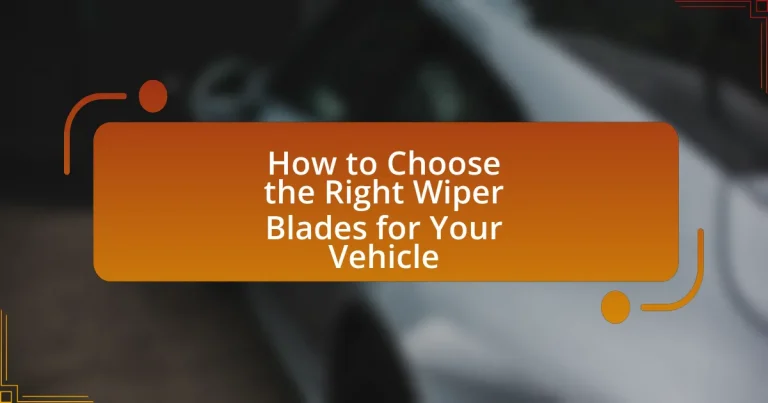Choosing the right wiper blades for your vehicle is essential for maintaining visibility and safety while driving. Key factors to consider include the size, type, and material of the blades, with options such as conventional, beam, and hybrid designs tailored for different weather conditions. The article outlines how weather impacts wiper blade selection, the signs indicating the need for replacement, and tips for comparing brands and avoiding common mistakes. Additionally, it emphasizes the importance of regular maintenance and proper installation to ensure optimal performance and safety on the road.

What Factors Should You Consider When Choosing Wiper Blades for Your Vehicle?
When choosing wiper blades for your vehicle, consider the size, type, and material of the blades. The size must match your vehicle’s specifications, which can typically be found in the owner’s manual or online databases. The type includes options like conventional, beam, or hybrid blades, each offering different performance characteristics; for example, beam blades provide better contact with the windshield and are more effective in heavy rain. The material affects durability and performance; rubber blades are common but may wear out faster than silicone blades, which can last longer and resist UV damage. Selecting the right combination of these factors ensures optimal visibility and safety while driving.
How do different weather conditions affect wiper blade selection?
Different weather conditions significantly influence wiper blade selection by determining the type of material and design needed for optimal performance. For instance, in regions with heavy rain, silicone wiper blades are preferred due to their durability and resistance to wear, providing better visibility. Conversely, in snowy or icy conditions, wiper blades with a winter design, featuring a rubber boot to prevent ice buildup, are essential for maintaining functionality. Additionally, in areas with extreme heat, wiper blades made from UV-resistant materials are necessary to prevent cracking and deterioration. These selections are supported by industry standards that recommend specific blade types based on climate conditions to ensure safety and effectiveness while driving.
What types of wiper blades are best for heavy rain?
The best types of wiper blades for heavy rain are beam blades and premium rubber blades. Beam blades feature a curved design that allows for better contact with the windshield, ensuring effective water removal during intense rainfall. Premium rubber blades are made from high-quality materials that resist wear and provide a smooth, streak-free wipe, enhancing visibility in heavy rain conditions. These blade types are specifically engineered to perform optimally under challenging weather, making them ideal choices for heavy rain scenarios.
Which wiper blades perform well in snowy or icy conditions?
Winter wiper blades perform well in snowy or icy conditions. These blades typically feature a rubber or silicone construction that remains flexible in low temperatures, preventing ice buildup. Additionally, winter wiper blades often have a protective cover that shields the blade from snow and ice, ensuring optimal contact with the windshield. Brands like Bosch, Rain-X, and Michelin are known for their effective winter wiper blade options, which are specifically designed to handle harsh winter weather.
What are the different types of wiper blades available?
There are three main types of wiper blades available: conventional, beam, and hybrid. Conventional wiper blades consist of a metal frame with a rubber blade, providing a cost-effective solution but may not perform well in extreme weather. Beam wiper blades feature a one-piece design without a frame, allowing for better contact with the windshield and improved performance in rain and snow. Hybrid wiper blades combine elements of both conventional and beam designs, offering the advantages of both styles, such as flexibility and durability. These distinctions are important for selecting the right wiper blades based on vehicle needs and environmental conditions.
What are the advantages of traditional frame wiper blades?
Traditional frame wiper blades offer several advantages, including durability, ease of replacement, and effective performance in various weather conditions. The metal frame provides structural integrity, allowing the blade to maintain consistent contact with the windshield, which enhances visibility during rain or snow. Additionally, traditional frame wiper blades are widely available and compatible with many vehicle models, making them a convenient choice for consumers. Their design allows for straightforward installation, often requiring no special tools. These factors contribute to their popularity and reliability as a wiper blade option.
How do beam wiper blades differ from conventional ones?
Beam wiper blades differ from conventional ones primarily in their design and performance. Beam wiper blades feature a sleek, aerodynamic structure that allows for better contact with the windshield, resulting in improved visibility and reduced streaking. In contrast, conventional wiper blades typically have a frame that can create gaps in contact, leading to less effective wiping performance, especially in adverse weather conditions. The design of beam blades also eliminates the need for a metal frame, making them more durable and less prone to ice and snow buildup, which is a common issue with conventional blades.
How do you determine the correct size of wiper blades for your vehicle?
To determine the correct size of wiper blades for your vehicle, consult your vehicle’s owner manual or use an online wiper blade size finder specific to your make and model. The owner manual typically lists the appropriate sizes for both the driver and passenger side wipers, ensuring a proper fit. Online tools, often provided by wiper blade manufacturers, allow you to input your vehicle’s details to find the exact sizes needed. This method is reliable, as it is based on manufacturer specifications, ensuring compatibility and optimal performance.
What tools can help you measure wiper blade size accurately?
To measure wiper blade size accurately, a tape measure or a ruler is essential. These tools allow for precise measurement of the length of the wiper blade from end to end, ensuring compatibility with the vehicle’s specifications. Additionally, some automotive stores provide wiper blade size charts or online tools that can cross-reference vehicle make and model to suggest the correct size, further enhancing accuracy in selection.
Where can you find the size specifications for your vehicle’s wiper blades?
You can find the size specifications for your vehicle’s wiper blades in the owner’s manual of your vehicle. The owner’s manual typically includes detailed information about the correct wiper blade sizes for both the driver’s and passenger’s sides. Additionally, many auto parts retailers and online platforms provide wiper blade size lookup tools based on your vehicle’s make, model, and year, ensuring you select the appropriate size for optimal performance.

What are the Signs That Indicate You Need to Replace Your Wiper Blades?
The signs that indicate you need to replace your wiper blades include streaking on the windshield, skipping or chattering during operation, and visible wear such as cracks or tears on the rubber. Streaking occurs when the wiper blades fail to make proper contact with the glass, which can impair visibility. Skipping or chattering indicates that the blades are not gliding smoothly, often due to damage or wear. Additionally, if the rubber shows signs of deterioration, such as cracks or tears, it compromises the effectiveness of the wipers. Regularly inspecting wiper blades can help ensure optimal performance and safety while driving.
How can you tell if your wiper blades are worn out?
You can tell if your wiper blades are worn out by checking for signs such as streaking on the windshield, skipping or chattering during operation, and visible wear or damage to the rubber. Streaking occurs when the blades fail to make proper contact with the glass, indicating that the rubber has hardened or deteriorated. Skipping or chattering happens when the blades are unable to glide smoothly, often due to bent frames or worn-out edges. Additionally, if you notice cracks, tears, or missing pieces on the rubber, it is a clear indication that the wiper blades need replacement. Regular inspection of wiper blades every six months is recommended to ensure optimal performance and safety while driving.
What visual signs should you look for on wiper blades?
Look for cracks, tears, or fraying on wiper blades as key visual signs indicating wear. These defects compromise the blade’s ability to clear water effectively, leading to streaking or reduced visibility. Additionally, check for hardened rubber or a shiny appearance, which suggests the material has deteriorated due to exposure to UV light and weather conditions. Regular inspection of these signs can help ensure optimal performance and safety while driving.
How does performance degradation indicate the need for replacement?
Performance degradation in wiper blades indicates the need for replacement when their ability to clear water and debris diminishes, leading to reduced visibility and safety risks while driving. As wiper blades age, factors such as wear, cracking, and loss of elasticity occur, which directly affect their performance. For instance, studies show that wiper blades should be replaced every six months to a year, as their effectiveness significantly declines after this period, resulting in streaks or missed spots on the windshield. This degradation not only compromises driving safety but also suggests that the blades can no longer perform their intended function effectively, necessitating replacement.
Why is it important to replace wiper blades regularly?
Regularly replacing wiper blades is crucial for maintaining optimal visibility and safety while driving. Worn or damaged wiper blades can lead to streaks, smears, or complete failure to clear water from the windshield, which significantly impairs a driver’s ability to see clearly during rain or adverse weather conditions. According to the American Automobile Association (AAA), poor visibility is a leading cause of accidents, emphasizing the importance of effective wiper performance. Additionally, manufacturers recommend replacing wiper blades every six to twelve months to ensure they function properly, as rubber deteriorates over time due to exposure to UV rays and environmental factors.
What risks are associated with using worn-out wiper blades?
Using worn-out wiper blades significantly increases the risk of impaired visibility while driving. This impairment can lead to accidents, as worn blades may leave streaks or fail to clear water effectively, especially during rain or snow. According to the National Highway Traffic Safety Administration, reduced visibility is a contributing factor in approximately 90% of all vehicle crashes. Therefore, maintaining wiper blades in good condition is crucial for safe driving.
How can regular maintenance of wiper blades improve visibility?
Regular maintenance of wiper blades significantly improves visibility by ensuring that they function effectively in clearing rain, snow, and debris from the windshield. When wiper blades are regularly inspected and replaced as needed, they maintain optimal contact with the glass, preventing streaks and smears that can obstruct a driver’s view. According to the American Automobile Association (AAA), worn or damaged wiper blades can reduce visibility by up to 30%, increasing the risk of accidents in adverse weather conditions. Therefore, consistent maintenance not only enhances safety but also ensures that drivers can see clearly in all driving situations.

What Tips Can Help You Choose the Best Wiper Blades for Your Vehicle?
To choose the best wiper blades for your vehicle, consider factors such as the correct size, type of blade, and material. First, consult your vehicle’s owner manual or use an online tool to determine the appropriate size for your wiper blades, as using the wrong size can lead to ineffective wiping. Next, select the type of blade that suits your driving conditions; options include conventional, beam, and hybrid blades, each designed for specific weather conditions. Finally, prioritize materials; rubber blades are common but silicone blades offer longer durability and better performance in extreme weather. According to a study by the Automotive Aftermarket Industry Association, using the right wiper blades can improve visibility and safety during adverse weather conditions.
How do you compare different brands of wiper blades?
To compare different brands of wiper blades, evaluate factors such as performance, durability, price, and customer reviews. Performance can be assessed through features like the blade material, design, and the ability to clear water effectively, with silicone blades often providing better longevity and performance in adverse weather conditions. Durability is typically indicated by the warranty period offered by the brand, with many reputable brands providing warranties ranging from six months to a year. Price comparisons can be made by analyzing the cost per blade and considering the balance between quality and affordability. Customer reviews on platforms like Amazon or automotive forums provide insights into real-world performance and satisfaction levels, helping to identify which brands consistently meet user expectations.
What features should you look for in high-quality wiper blades?
High-quality wiper blades should feature durable materials, effective design, and reliable performance. Durable materials, such as silicone or high-grade rubber, resist wear and provide a longer lifespan compared to standard rubber blades. Effective design includes a flexible frame that conforms to the windshield’s curvature, ensuring optimal contact and coverage. Reliable performance is characterized by a smooth, streak-free wipe, which can be verified through user reviews and product testing results, indicating that high-quality blades significantly improve visibility during adverse weather conditions.
How can customer reviews influence your choice of wiper blades?
Customer reviews significantly influence the choice of wiper blades by providing real-world insights into performance and durability. When potential buyers read reviews, they can assess the effectiveness of different brands and models based on the experiences of other consumers. For instance, a study by BrightLocal in 2022 found that 79% of consumers trust online reviews as much as personal recommendations, highlighting the impact of peer feedback on purchasing decisions. Additionally, reviews often detail specific attributes such as noise levels, streaking, and ease of installation, which can guide buyers in selecting wiper blades that best meet their needs.
What are some common mistakes to avoid when selecting wiper blades?
Common mistakes to avoid when selecting wiper blades include choosing the wrong size, neglecting to consider the type of wiper blade, and failing to check compatibility with the vehicle. Selecting the incorrect size can lead to ineffective wiping and potential damage to the windshield, as wiper blades must match the specific dimensions recommended by the vehicle manufacturer. Ignoring the type of wiper blade, such as traditional, beam, or hybrid, can result in suboptimal performance in various weather conditions; for instance, beam blades are often more effective in heavy rain. Lastly, not verifying compatibility with the vehicle’s wiper arm design can lead to installation issues, as different vehicles may require specific attachment methods.
How can incorrect sizing affect wiper blade performance?
Incorrect sizing of wiper blades can significantly impair their performance by causing inadequate contact with the windshield. When wiper blades are too short, they may leave streaks or uncleaned areas, while oversized blades can lead to improper movement and potential damage to the vehicle’s body or glass. Studies indicate that properly sized wiper blades enhance visibility during adverse weather conditions, which is crucial for safe driving. Therefore, ensuring the correct size is essential for optimal wiper function and overall driving safety.
What should you consider about installation when choosing wiper blades?
When choosing wiper blades, consider the installation type, as it affects compatibility and ease of use. Different wiper blades have various attachment mechanisms, such as hook, pin, or bayonet styles, which must match your vehicle’s wiper arm design for proper installation. Additionally, some wiper blades come with installation instructions or tools, making the process simpler. Ensuring that the chosen wiper blades are compatible with your vehicle’s specifications will facilitate a secure and effective installation, enhancing performance during use.


